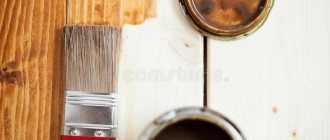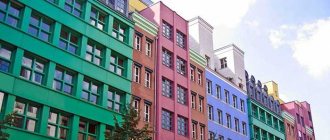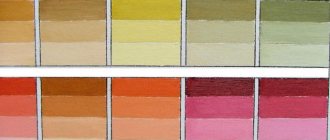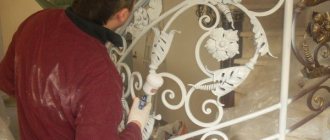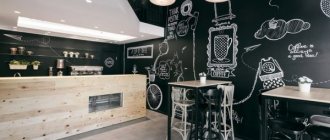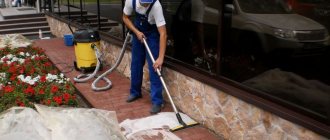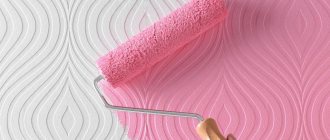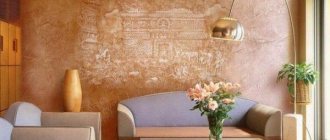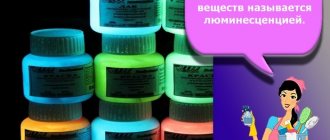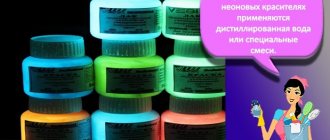General requirements for paints for external work
The operating conditions of facade walls are difficult. Surfaces are negatively affected by precipitation, climatic temperature conditions, and solar radiation. Accordingly, paints must withstand these factors for a long time, without deteriorating their original characteristics for as long as possible.
Choosing facade paints
What are the criteria for choosing façade paints?
| Parameter name | Short description |
| Alkali resistance | Many bricks emit alkali, this feature is due to the presence of chemical compounds in the clay. Depending on their percentage, the release of alkalis can be visible (so-called efflorescence) or invisible. But they are always there. The paint should not peel off on such surfaces. |
| Resistant to fading | Sun rays have a negative effect on paint; over time, it can change color. If you use low-quality materials, the walls of the building will become multi-colored over time. On the south side they will become lighter, but on the north side they will retain their original shade. |
| Weather resistance | The coating must reliably protect the brick and mortar in the joints from moisture penetration. Wet materials expand when they freeze, causing ice crystals to form on the surface and damage the paint. As a result, it peels off and will have to be repaired. |
| Vapor permeability | A brick wall does not “breathe” well; if the paint further reduces vapor permeability, this worsens the microclimate in the room and negatively affects the stability of architectural structures. |
| Mechanical strength | The paint should not be scratched and withstand not only one-time mechanical loads, but also long-term exposure to abrasive dust. |
| Adhesion indicators | The strength of adhesion to the surface should ensure a long service life. Moreover, good adhesion should be not only with brick, but also with cement-sand mortar. |
| Plastic | When the wall heats up, it expands. The coating should easily compensate for thermal linear expansion. |
| Manufacturability | The paint should be easy to apply with simple devices and dry relatively quickly. Do not require the use of personal respiratory and skin protective equipment. |
The list of special requirements is long, and as a result, the price of materials with such properties cannot be low. And one last thing. The service life of paint depends on the brand and manufacturer, but rarely exceeds 10 years. At the end of this period, repairs will have to be made. Keep this in mind when making your final decision about painting your brick exterior walls.
When is it necessary to paint a brick base?
This is necessary if the facade of the house or a brick fence:
- Covered with white coating (efflorescence). These salt particles come to the surface, which gradually destroy the brick base, making it brittle and brittle. It is impossible to wash off the salt. Before painting, it is necessary to treat the surface with a special acid-based product.
- They have lost their original aesthetic appearance (the color has faded, ugly abrasions have appeared).
- Partially collapsed. Before painting, it is necessary to plaster the damaged areas.
- I just got tired of it and wanted to change the general decor of the buildings.
In these cases, brick paint will help strengthen the crumbling foundation and give the house and fence a decent appearance.
General requirements for paints for interior work
For interior work, paints have different requirements. In addition to the above properties, security is added. The paint cannot contain hazardous chemical compounds; it is advisable to use water-based brands. As for resistance to sunlight and moisture permeability, the indicators are not so strict.
Balcony with painted brick wall
When the need for painting arises
Painting a brick wall is quite difficult, but in some situations it is necessary. The main reason for painting interior walls is aesthetic. Properly selected design creates the right atmosphere in the room - a working atmosphere in the office and a good atmosphere in the bedroom. If you have imagination, you can create real paintings on the interior walls.
Another reason is purely practical. Internal walls are exposed to harmful influences - humidity, dust, household aerosols, interior work - all of them harm the brickwork, although less than external walls. Paint helps reduce the load on the walls, and repainting the surface is easier than repairing cracks and dents in brick, even small ones. If there are already defects, paint will help disguise them.
General requirements for paints for painting stoves and fireplaces
Brick stoves and fireplaces reach high temperatures. An additional requirement for materials is resistance to heat. Ordinary paints quickly fade and peel under such conditions. Before purchasing paint, carefully study the instructions for use; manufacturers specifically indicate possible places of use.
Painted fireplace
Types of painting materials for bricks
There are two types of brick paint - water-based and oil-based. For interior work, it is water-based compositions that are better suited because they allow air to pass through, do not disturb the structure of the brickwork and to a lesser extent provoke the formation of efflorescence (salt or lime deposits that appear on the external (less often on internal) walls of the building, the reason is the difference in humidity) and drips . The disadvantage is that not all water-based paints are wash-resistant; this needs to be clarified when purchasing. Oil paints can be used for exterior work (not always), but are not suitable for painting interior spaces.
Types of water compositions:
- Acrylic;
- Silicone;
- Silicate;
- Mineral;
- Combined.
All of them are suitable for working on any brick surface - both inside and outside the house.
Acrylic paint is economical in consumption when the surface is properly prepared. Not damaged by water and detergents, can be used in bathrooms and kitchens if there is good ventilation. Vapor permeability indicators vary greatly - for interior work they must be significant, i.e. the paint must be more permeable to water vapor than the brick it is applied to.
Silicone compounds allow steam to pass from inside the room to the outside, preventing moisture from accumulating in the room. Fungus and bacteria do not multiply on treated surfaces, walls are easy to clean, and dirt is easily washed off. In addition, such paints retain their appearance for a long time and do not fade, including under the influence of ultraviolet radiation. The disadvantage is the price.
Designer paint and brick-like plaster are used to create the intended appearance of the wall. It can be used on brick walls and other materials.
Silicate mixtures (liquid glass) are resistant to influencing factors and extremely durable (the stated service life is up to 20 years). They tolerate sunlight well in south-facing rooms, splashes and periodic washing in the kitchen, and prevent the spread of germs, mold and dampness. They are destroyed if they are exposed to high humidity for a long time (toilet, bathroom or basement with poor ventilation).
Mineral – cement-based paints. They harden quickly and withstand damaging factors well. Rarely used for interior work.
Types of paints for bricks
We will not be able to list all types of materials; we will focus only on the most commonly used ones. The listed paints have earned positive reviews not only from users, but also from professional painters.
| Name | Properties and recommended places of use | approximate cost |
Zealand | Water-dispersed, acrylic. Has high resistance to alkalis. Can be used for painting brick, concrete, cement-sand plaster. | From 320 rub. |
Sicily | To improve performance it has silicone additives. It has increased elasticity and resistance to harsh ultraviolet rays. Does not allow moisture to pass through, does not fade, the surface inhibits the growth of moss. It does not require much time for periodic cleaning and is easy to clean with ordinary water and a garden hose. | From 430 rub. |
Mineral Strong | Acrylic water-dispersion, facade, alkali-resistant. It does not fade for a long time and does not crack due to changes in the linear dimensions of surfaces. | From 770 rub. |
Winterall | One of the newest developments, universally applicable, characterized by improved performance. Does not change shade, is not afraid of mechanical influences. | From 1520 rub. |
Siloxane | I clean myself, dust is washed away by natural precipitation, with a lotus effect, the surface does not get wet, raindrops slide off. One of the most expensive and high quality. | From 1650 rub. |
Professionals do not advise saving too much and buying paints of dubious quality. It must be remembered that the cost of premature repairs always far exceeds the savings on the price of the material.
Prices for different types of construction paints
Construction paint
Types of coatings
Facade paint for bricks is based on water or organic compounds. Each variety has its own characteristics, positive and negative sides. It is important for the buyer to decide which features to give priority to.
Organosoluble nitro enamels and oil dyes
They have the following characteristics:
- Good penetration into brick structure.
- UV resistant.
- Creation of a thin water-repellent film on the surface, which prevents the original material from “breathing”. Because of this, condensation appears on the surface in large quantities.
Organosoluble paints for facades are recommended to be avoided by those who are furnishing the interior of residential premises. Otherwise, the walls will become damp too quickly, and the microclimate inside will be disrupted. External facades, fences and brick walls are optimal for paints. The composition of the material is toxic. At the same time, it is protected from burnout and atmospheric precipitation.
Water soluble
These are some of the most durable paints for painting walls. They are even suitable for processing gas heating drafts and stove heating pipes. Sometimes this material is used for finishing work inside the house. Compatible with different types of materials:
- Gypsum tiles with brick imitation.
- Gypsum, silicate brick.
- Simple brick.
Water-soluble paints are capable of transmitting steam. Exchange of gases and liquids occurs normally between the atmosphere and the surface. Fireproof, non-toxic material. It is allowed to use it to decorate the interior of premises. Some varieties have heat-resistant qualities when painted.
Epoxy
Customers can give the compositions different properties according to their wishes. Resins have a toxic or non-toxic composition. Adhesion properties and high strength are always characteristic of paints. Atmospheric precipitation can cause some damage to materials. Painting the inside of walls with this composition will guarantee durability and high-quality coating. Can be used inside covered balconies.
Such paints can be used in conjunction with varnishes to improve quality. The main thing is to choose non-toxic solutions when it comes to living rooms. On the packaging it is recommended to study the areas of application and the composition used.
Mineral
The basis for the manufacture of the material in this case is ordinary cement. This paint is suitable for painting facades from both a practical and decorative point of view. The paint can be used to treat balconies and fences. It has the following characteristics when painting sand-lime brick with facade paints:
- Water resistance.
- Heat resistance.
- High temperatures and large amounts of precipitation do not cause serious damage.
The fence or façade of buildings will be reliably protected from further damage. This option is rarely seen when interior spaces are being decorated.
Silicone
Mixtures with silicone are the choice for buyers if the base has low adhesion properties. Such materials are well distributed over the treated surfaces. For a long time they are able not to change color. Stoves and fireplaces are decorated with heat-resistant varieties.
Technology for painting brick surfaces
The quality of the paint affects the durability of the coating of brick walls by no more than 50%; everything else depends on the thorough preparation of the surfaces and the accuracy of the technology. Take your time, follow all the recommendations. Any correction of a marriage requires not only additional money, but also a lot of time. The painting process itself is divided into two stages of equal importance: surface preparation and application of the material. Let's consider these operations in detail.
Surface preparation
So, you have decided to paint the brick façade walls.
Step 1. Take measurements of the surfaces minus the area of door and window openings. There is nothing complicated here, there is no need to go into detail.
Facade paint consumption per 1m2
Take measurements and record the results in a table
How to calculate wall area
Step 2: Choose a paint brand and color. Read the instructions for use and determine the quantity according to the recommendations. We strongly recommend that you reserve approximately 10% of the paint. Why? Firstly, you will be able to work more calmly. Secondly, no manufacturer can know the exact characteristics of the surfaces of your walls, and it depends on them how much paint will be absorbed and exactly how much will be needed to complete the work. Thirdly, a small supply of paint will always come in handy if you need to urgently repair a damaged section of a façade wall.
Shades of colors
Step 3 . Inspect the surface of the wall, determine the method of its preparation depending on the origin and intensity of contamination and the condition of the brick. This is a very responsible job, mistakes made are difficult to correct. What to pay attention to when inspecting the condition of the wall?
- Presence of concrete mixture residues on the surface of the bricks.
- Condition of the seams: filling, mechanical strength, appearance.
- The condition of the front surfaces of the brick - are there any delaminations and depressions.
- Are there efflorescences, how many are there and what intensity are they?
Assess the condition of the brick wall surface
Step 4. Prepare the surface of the brick wall for painting. To do this you will need a metal brush or drill, a spatula, acetic acid, rags, a broom, and a compressor. If it is possible to do soft blasting, great. We will tell you what it is and how it is done throughout the article.
Wall preparation is divided into several stages.
Clean the wall of any stuck mortar. Use a trowel, spatula and wire brushes. The mortar adheres firmly to the brick - you can cut it off with a chisel. Carefully inspect the surfaces and remove dust.
Cleaning the wall with a brush
If you find crumbling bricks on the wall, be sure to do some repairs. If possible, dig out the bad brick as deeply as possible; you should get to the solid body. Next you need to fill the hole with solution. Large hole depth - throw into several openings, let each layer harden and dry a little, otherwise deep cracks will appear on the surface.
Brickwork repair
Do not wait until the cement has completely cured. It is advisable to make jointing under the brick seam in the scattered mortar after an hour and a half; if the mortar completely hardens, the work will become more complicated. Use wooden sticks or any available materials; the width and depth of the new seam should not differ from the dimensions of the old one. After painting the wall surface, the repaired area is no different from neighboring areas.
Use a handy tool for jointing
Check the condition of the seams. The biggest problem is that when laying the walls, the craftsmen did not adhere to the mortar making technology and provided very little cement. This solution crumbles a little in the seams, the paint does not adhere to these places. The situation is very unpleasant. What to do? There are two options, but both of them require a lot of time.
- First. Deepen the seam by 3-4 millimeters, make a new high-quality paste and carefully straighten all the seams. You need to immediately remove any fresh mortar that gets on the front of the brick.
- Second. Buy a special primer and use a small brush to treat the seams. The number of treatments is at least two. The primer must have deep penetration.
Deep penetration soil
Apply primer to the joints of the masonry with a brush.
If there are efflorescences, they must be thoroughly cleaned. You can wash it with a vinegar solution, but this has little effect. The fact is that this is not surface pollution, but protruding salts from the bricks. Efflorescence will appear again until all the brine comes out of the bricks. The surface can be painted only after new crystals have stopped appearing; only the white spots are painted over. The work of clearing efflorescence is very difficult and lengthy. Unfortunately, even great efforts do not always lead to a positive result; you have to look for other methods to eliminate the problem. Modern materials and technologies make it possible to solve them much faster and easier than painting. We advise you to think carefully before attempting to paint over efflorescence areas.
How to remove efflorescence on brick
Once the walls are prepared, give them time to dry completely, at least a week of good warm and dry weather will be needed. Only after this can you start painting. Immediately close windows and doors to prevent paint from entering. Cover them with plastic wrap and tape. Make sure that the adhesive tape is held firmly; it is difficult to clean windows and doors of paint that gets in.
If it is possible to clean a brick wall with soft blasting, great. The work not only speeds up, but the quality improves. In addition, this is one of the few ways to remove graffiti or other inscriptions, soot, soot, and burning smell from the surface of brick walls. The technology allows you to completely remove contaminants without disturbing the safety of the top layer. Baking soda (sodium bicarbonate) and chalk (calcium carbonate) are used for cleaning.
Soft blasting
Water jet cleaning
The components are fed through a calibrated nozzle onto the surfaces to be cleaned with an air stream under high pressure. Modern devices reduce material consumption by about 30% and at the same time increase labor productivity. The cost of cleaning is reduced by at least 20%, all work can be done during one work shift. The disadvantage is the high cost of the device.
Prices for deep penetration primers
Deep penetration primer
Painting brick facade walls
You can paint with brushes, rollers and pneumatic sprayers. Depending on the painting method, the requirements for paints vary slightly. For a brush and roller it may be a little thicker; for a spray bottle it should be diluted with a solvent.
Spray painting
Important. After preparation, pour the spray paint into the container only through a special sieve.
Painting the facade with a spray gun
Prices for paint sprayers
Spray gun
What are the features of working with a spray gun?
- Do not buy cheap spray guns, they have a high paint consumption. A jet bursts out of the nozzle in different directions and at different speeds, a lot of material goes “nowhere”.
- Movements should be down/up, not left/right. If you notice an omission, correct it immediately.
- Never stop your hand, the hand should constantly move.
A properly adjusted modern spray gun can save up to 10% of paint and improve the quality of painting. Microparticles of paint hit the surface of the brick with great force and penetrate into all the cracks. Another important advantage of spray guns is that after using them there is no need to re-correct the surface.
Painting with roller and brush
Applying paint to a brick wall
Traditional method of painting various surfaces. The work goes faster with a roller than with a brush, but the kvass does not get into deep seams. We have to go through the wall again with a brush. In addition to low labor productivity and high labor intensity, these methods have another significant drawback. During work, grains of sand-cement mortar stick to them, remain on the front surfaces of the bricks and become noticeable. The appearance of the painted wall deteriorates significantly.
Applying paint to a wall using a roller
Preparatory work
In order for the paint to exhibit its declared properties, it is necessary to prepare the walls before painting. Pre-preparation takes longer than applying paint. The work is carried out in several stages.
Stripping old coating
The initial stage of work is removing the old coating. It is removed with a scraper, spatula, or metal brush. If there are traces of efflorescence or lime deposits, solvents are used. Inspect the seams, clean if necessary and fill with new solution. After treatment, wait until it dries and give it 1-2 weeks to check whether the stains appear again.
Sealing cracks
The wall is inspected, the locations of brick chips and cracks are determined. All defects are filled with putty. After leveling the surface, wait until it dries completely. Sand the repair areas with sandpaper.
Surface priming
The primer will help save paint and improve adhesion. The material is chosen together with the paint, on the same basis. The soil is placed in 2-3 layers and carefully leveled. If there are grease marks on the wall, prime with a thick layer.
Tool preparation
To paint brick walls you will need the following set of tools:
- brushes for painting corners and difficult places - made of polyester or natural hair, width - 8-10 centimeters;
- paint container;
- tools for painting the main area - a spray gun, a roller (nap 2 centimeters), a painting machine.
See also
Technical characteristics and composition of KO-868 enamel, its scope
You will also need protective equipment - a respirator, overalls, goggles, gloves.
Calculation of material consumption
Manufacturers indicate consumption per square meter on the paint. Before purchasing, you need to calculate the area of the walls. Different types of paints are applied in layers of a certain thickness, so you should follow the recommendations on the packaging. For the second and third layers, consumption is reduced by 20-60%, depending on the base.
Technology and choice of paint for interior work
As we have already mentioned, interior paints cannot contain harmful chemical compounds. Paint is applied in most cases with a roller or brush. There are options for painting the surface of bricks and seams in various colors.
Before starting work, take measures to protect floor coverings from paint. Cover them with thick paper or plastic wrap. Clear your workspace and place the paint container in a convenient place. Be careful not to spill paint on the floor.
Practical advice. The roller should move at a moderate speed. Rotating too quickly can cause paint splatters to fly over long distances and land on other objects.
Painted wall
The second layer is applied after the first has partially dried; to improve adhesion, do not let it dry completely. How to check the position of the first layer? Gently run your fingertips over the surface; if they stick a little, you can apply a second coat of paint.
Each brick can be painted a different color
How to paint brick facade walls
For facade work, use a roller with different attachments or a special paint sprayer.
Spray
The work is performed in a respirator. Before filling the device, the paint is thoroughly stirred, then filtered to remove large fractions. Basic rules for applying dye to masonry:
- install side lighting;
- the jet is directed perpendicular to the wall;
- distance – from 40 centimeters;
- the sprayer is moved at one speed.
Usually 3 layers of dye are applied, the first - in vertical movements, the next - in a horizontal plane.
Roller
How to paint a brick with a roller, the main details of the work:
- paint is poured into the tray;
- thoroughly soak the roller, remove excess dye from the grooved part of the container;
- apply paint in different directions - vertically, horizontally, at an angle;
- the strips are made with a slight overlap on each other (not at the joint).
The main difficulty is poor painting of the seams; they often have to be covered with a brush.
Painting the stove
Recently, country style has come into fashion, and it involves using the maximum number of traditional rustic elements in the design of the premises. The most traditional element of ancient dwellings is the Russian stove. Today it is placed not only as a decorative element, but also as an active one. The surface temperature can exceed one hundred degrees; not every paint can withstand such harsh operating conditions. Previously, stoves were painted with lime - cheap, hygienic, reliable and fast. The disadvantage is that the paint had to be repainted every year; the lime quickly wore off.
Currently, almost no one uses lime; it has been replaced by water-based paints that are resistant to high temperatures and safe for residents. Before purchasing, be sure to pay attention to the manufacturers' recommendations for use; buy only materials that are resistant to high temperatures. The technology for painting surfaces is no different from that described above.
Heat resistant paint
Furnace painting
Brick stove in a modern interior
It's a little easier with fireplaces. The design of fireplaces does not provide for large surface heating; their efficiency is the lowest among all heating devices. For the most part, a fireplace is installed for prestige and beauty; it is warm around it only when wood is burning. The fire has gone out - you need to look for another place for comfortable heating. Such design features make it easier to choose a specific paint; apart from safety for others, no additional conditions are imposed.
Prices for heat-resistant paints
Heat resistant paint
Overview of paints for brickwork
There are several manufacturers that are recognized as leading in this area.
- Galamix. Russian production, with the widest range of products.
The company produces textured paint for mineral surfaces, for wooden bases, and matte varieties. This is an environmentally friendly material that, with the right approach, can last up to 8 years or more. These materials can hide rough, uneven surfaces without any problems. The price per square meter is average.
- Dulux.
A series of facade paints from England. It produces a variety of products, including matte, quick-drying organic compositions, textured and acrylic materials, on a water-based basis. The facade with these paints is protected from mold and fungi, the materials retain strength and durability.
- Beckers.
Company from Sweden. It is engaged in the production of matte water-based versions, acrylate compositions on latex, alkyd oil paints with the addition of linseed oils. Paints are easy to treat surfaces made of
- Products from the Finnish company Ticurilla. It produces base and lime, silicate compositions, acrylic-silicate varieties.
- Russian paints “Svyatozar”.
- Baumit.
General Tips
You will have to paint in at least two layers. If the paint is light in color, then two coats may not be enough. Buy paint based on the number of layers.
We recommend using a primer. It greatly increases the adhesion of compounds and reduces material consumption. The cost of primer is significantly cheaper than paint, which increases the economic efficiency of its use.
Apply primer to the wall before painting
When choosing rollers, give preference to soft options. Hard ones leave a lot of gaps on uneven surfaces.
Cover the junctions of brick walls or elements with other structures with masking tape. If you have some practical skills, do not glue anything, but at the joints, finish the remaining unpainted surfaces with a brush. If you work carefully, the junction line will be smooth, you won’t have to correct or clean anything.
Painting a brick wall
Painted brick facade
How to paint brick?
Painting sand-lime brick is not a complicated process. To cover a wall with paint, use standard tools: roller, brush, sprayer. In order for the mixture to adhere well, the surface should be pre-prepared:
- The surface must be dry. You need to make sure that the brick is not wet.
- Apply only to a base that has been cleared of old dye. Previously painted bricks must be thoroughly cleaned and washed. Wipe off dust, mold, excess solution, dirt.
- Be sure to clean off the white deposits - these are salts washed out of the brick by moisture. Before painting a brick wall, you should clean it thoroughly with a brush and/or water.
- It is advisable to use a primed surface. This technique will be more expensive, but the quality of applying the mixture to the wall will be significantly higher.
Recommendations
Regardless of the type of paint for brick walls, there must be good ventilation in the room where work is carried out. The smell of paint does not contribute to good health, and in severe cases causes poisoning. For those with a sensitive sense of smell, a respirator is needed in addition to open windows.
Some paints need to be diluted (this is written in the instructions). In this case, the instructions must be followed very strictly - use only the recommended solvent and only in the specified amount. Failure to follow the rules will result in the paint applying unevenly or being damaged.
In rooms with high humidity - kitchens, bathrooms, basements - it makes sense to varnish the paint. This will make the coating durable and improve its appearance. The varnish can be applied in several layers.
Anyone can paint a brick wall in a house - with the right approach, this process does not require professional skills.
Review of popular manufacturers
Every year, a rating of the best products in their segment and manufacturers is compiled. This event was not spared by façade paints for bricks.
There are also Akrial-Lux, Caparol and many others, the choice of which depends on the financial capabilities of buyers, as well as on specific characteristics.
Using a roller and brush
A roller and brush is a classic way to paint walls. Anyone can use them, even without being a painter. A roller is needed to evenly apply paint over large areas; it is convenient for painting walls in a single color or applying the main tone, on top of which the rest will be applied. The brush is convenient for painting corners and correcting minor defects. For artistic painting, sets of brushes of different thickness and hardness are used.
Do not use oil-based paint for bricks - these products lead to condensation and the accumulation of moisture in the house
Rollers and brushes come in different types, and you need to choose the one that is suitable for the type of paint and task you choose. All types of rollers are suitable for working with water-based paints; the cheapest option is foam rubber, but it deteriorates the fastest. Other options are fur, polyamide, velor. Rubber rollers are not used for painting.
Universal brush for painting work – flat. It allows you to paint the surface evenly, is easy to clean, and can be used to clean surfaces from light dirt. Its variety - a radiator brush - will help you carefully paint corners and radiators. Round brushes of different diameters are used for drawings on walls.
Which one to choose for painting a brick facade?
External walls are often finished with facing bricks.
This brick does not require additional coating. But there are cases when it is necessary to paint sand-lime brickwork. For example, you want to update an old wall or emphasize a masonry element. Sand-lime brick consists of quartz sand and lime, so you need to choose a coloring composition with high resistance to alkali. The properties are similar to ceramic, i.e. clay, but less water resistant
Therefore, when choosing a paint composition, the main attention should be paid to moisture resistance.
Most often, acrylic paints are used for these purposes, which, in addition to high moisture resistance, have good vapor permeability, wear resistance and an affordable price. Sand-lime brick has a light surface, so it is possible to use almost any color in painting. Just remember that when repairing a painted surface, it is often impossible to change the color of the coating, because the darker color will show through the lighter paint.
How to prepare paint
After standing on a shelf for a long time, any paint begins to flake a little - it becomes thinner at the top and thicker at the bottom. If you apply it in this form, the color will turn out uneven. Therefore, the paint must be mixed before use.
Mixer attachment for convenient dilution of building mixtures Source saratov24.tv
It is best to do this using a special attachment on a drill or hammer drill, especially when it comes to large volumes. In principle, paint in a small jar of a couple of liters can be mixed manually with a brush or wooden stick.
You should act in the same way when combining several colors of paint or adding a colored pigment. It’s not enough to just pour them into one container, you need to mix them well.
Which one to choose for painting a brick facade?
External walls are often finished with facing bricks. This brick does not require additional coating. But there are cases when it is necessary to paint sand-lime brickwork.
For example, you want to update an old wall or emphasize a masonry element. Sand-lime brick consists of quartz sand and lime, so you need to choose a coloring composition with high alkali resistance. The properties are similar to ceramic, i.e. clay, but less water resistant
Therefore, when choosing a paint composition, the main attention should be paid to moisture resistance.
Most often, acrylic paints are used for these purposes, which, in addition to high moisture resistance, have good vapor permeability, wear resistance and an affordable price. Sand-lime brick has a light surface, so it is possible to use almost any color in painting. Just remember that when repairing a painted surface, it is often impossible to change the color of the coating, because the darker color will show through the lighter paint.
Latex paint for facade
Latex paint is made on the basis of natural rubber resins, and today it can be called one of the most popular options for painting facades. Let us immediately note that this pleasure is not cheap, but the service life of such paint, according to the manufacturers, is at least 25 years under the most intense load.
Another feature of latex paint that can be considered an advantage is its environmental friendliness. The paint does not contain chemical components, so even during operation it does not emit any unpleasant odors.
Interesting! Often latex paint is also used for work in an apartment, since it has no odor, but here it is important to remember that facade paint differs from that used for interior work, and its price is significantly higher.
Characteristics and Features
Features of latex paint:
And finally, one more rule that should not be forgotten: do not mix latex paint with materials on a different base. Thanks to the water base, curdling will not occur, but adhesion will be completely disrupted, and the entire mixture will have to be thrown away.
Activity algorithm
Repair work begins with the selection of time and materials. You need to start only a year after building the house, but not earlier. It is best to carry out repairs in the summer, in warm and dry weather. Humidity from the street can penetrate inside the house when the windows are open (and this is necessary when working with paint), so you still need to take the weather into account.
The choice of material depends on the quality of the wall, the desired effect and budget. In addition to brick paint, you need to buy:
- Wall primer material – hides defects and makes the painting process more convenient;
- Application tools;
- Coating varnish – protects the paint from harmful influences, increases durability and moisture resistance.
All components must fit together. The ideal option is to buy them from the same company as the product line.
The surface is prepared for application of paint, then painted using a roller, brush or spray. If more than one layer is intended, then each of them must dry before applying the next, unless the instructions say otherwise. After the last layer has dried, apply varnish (this can also be done in several layers).
